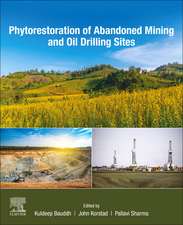Time and Methods in Environmental Interfaces Modelling: Personal Insights: Developments in Environmental Modelling, cartea 29
Autor Dragutin T Mihailovic, Igor Balaž, Darko Kaporen Limba Engleză Hardback – 13 noi 2016
As the field of environmental science requires the application of new fundamental approaches that can lead to a better understanding of environmental phenomena, this book helps necessitate new approaches in modeling, including category theory, that follow new achievements in physics, mathematics, biology, and chemistry.
- Includes the use of new mathematical tools, such as category theory, mathematical theory of general systems and formal concept analysis, matrix theory tools, stability analysis, and pseudospectra
- Presents new content related to time in relation to physics and biology
- Combines the word of an experienced author team with over 35 papers of collective experience
Preț: 558.04 lei
Preț vechi: 772.57 lei
-28% Nou
Puncte Express: 837
Preț estimativ în valută:
106.80€ • 111.08$ • 88.16£
106.80€ • 111.08$ • 88.16£
Carte tipărită la comandă
Livrare economică 07-21 aprilie
Preluare comenzi: 021 569.72.76
Specificații
ISBN-13: 9780444639189
ISBN-10: 0444639187
Pagini: 412
Dimensiuni: 191 x 235 x 26 mm
Greutate: 1.02 kg
Editura: ELSEVIER SCIENCE
Seria Developments in Environmental Modelling
ISBN-10: 0444639187
Pagini: 412
Dimensiuni: 191 x 235 x 26 mm
Greutate: 1.02 kg
Editura: ELSEVIER SCIENCE
Seria Developments in Environmental Modelling
Cuprins
Part I: Introduction
Chapter 1. Environmental interface: Definition and introductory comments
Chapter 2. Advanced theoretician's tools in the modelling of the environmental interface systems
Chapter 3. Approaches and meaning of time in the modelling of the environmental interface systems
Chapter 4. Examples of use of the formal complex analysis
Part II: Time in Environmental Interfaces Modelling
Chapter 5. Time in philosophy and physics
Chapter 6. Time in biology
Chapter 7. Functional time: Definition and examples
Part III: Use of Different Coupled Maps in the Environmental Interfaces Modelling
Chapter 8. Coupled logistic maps in the environmental interfaces modelling
Chapter 9. Logistic difference equation on extended domain
Chapter 10. Generalized logistic equation with affinity: Its use in modelling heterogeneous environmental interfaces
Chapter 11. Maps serving the different coupling in the environmental interfaces modelling in the presence of noise
Part IV: Heterarchy and Exchange Processes Between Environmental Interfaces
Chapter 12. Heterarchy as a concept in environmental interfaces modelling
Chapter 13. Heterarchy and biochemical substance exchange in a diffusively coupled ring of cells
Chapter 14. Heterarchy and albedo of the heterogeneous environmental interfaces in environmental modelling
Part V: Complexity Measures and Time Series Analysis of the Processes at the Environmental Interfaces
Chapter 15. Kolmogorov complexity and the measures based on this complexity
Chapter 16. Complexity analysis of the ionizing and nonionizing radiation time series
Chapter 17. Complexity analysis of the environmental fluid flow time series
Chapter 18. How to face the complexity of climate models?
Part VI: Phenomenon of Chaos in Computing the Environmental Interface Variables
Chapter 19. Interrelations between mathematics and environmental sciences
Chapter 20. Chaos in modelling the global climate system
Chapter 21. Chaos in exchange of vertical turbulent energy fluxes over environmental interfaces in climate models
Chapter 22. Synchronization and stability of the horizontal energy exchange between environmental interfaces in climate models
Part VII: Synchronization and Stability of the Biochemical Substance Exchange Between Cells
Chapter 23. Environmental interfaces and their stability in biological systems
Chapter 24. Synchronization of the biochemical substance exchange between cells
Chapter 25. Complexity and asymptotic stability in the process of biochemical substance exchange in multicell system
Chapter 26. Use of pseudospectra in analyzing the influence of intercellular nanotubes on cell-to-cell communication integrity
Chapter 1. Environmental interface: Definition and introductory comments
Chapter 2. Advanced theoretician's tools in the modelling of the environmental interface systems
Chapter 3. Approaches and meaning of time in the modelling of the environmental interface systems
Chapter 4. Examples of use of the formal complex analysis
Part II: Time in Environmental Interfaces Modelling
Chapter 5. Time in philosophy and physics
Chapter 6. Time in biology
Chapter 7. Functional time: Definition and examples
Part III: Use of Different Coupled Maps in the Environmental Interfaces Modelling
Chapter 8. Coupled logistic maps in the environmental interfaces modelling
Chapter 9. Logistic difference equation on extended domain
Chapter 10. Generalized logistic equation with affinity: Its use in modelling heterogeneous environmental interfaces
Chapter 11. Maps serving the different coupling in the environmental interfaces modelling in the presence of noise
Part IV: Heterarchy and Exchange Processes Between Environmental Interfaces
Chapter 12. Heterarchy as a concept in environmental interfaces modelling
Chapter 13. Heterarchy and biochemical substance exchange in a diffusively coupled ring of cells
Chapter 14. Heterarchy and albedo of the heterogeneous environmental interfaces in environmental modelling
Part V: Complexity Measures and Time Series Analysis of the Processes at the Environmental Interfaces
Chapter 15. Kolmogorov complexity and the measures based on this complexity
Chapter 16. Complexity analysis of the ionizing and nonionizing radiation time series
Chapter 17. Complexity analysis of the environmental fluid flow time series
Chapter 18. How to face the complexity of climate models?
Part VI: Phenomenon of Chaos in Computing the Environmental Interface Variables
Chapter 19. Interrelations between mathematics and environmental sciences
Chapter 20. Chaos in modelling the global climate system
Chapter 21. Chaos in exchange of vertical turbulent energy fluxes over environmental interfaces in climate models
Chapter 22. Synchronization and stability of the horizontal energy exchange between environmental interfaces in climate models
Part VII: Synchronization and Stability of the Biochemical Substance Exchange Between Cells
Chapter 23. Environmental interfaces and their stability in biological systems
Chapter 24. Synchronization of the biochemical substance exchange between cells
Chapter 25. Complexity and asymptotic stability in the process of biochemical substance exchange in multicell system
Chapter 26. Use of pseudospectra in analyzing the influence of intercellular nanotubes on cell-to-cell communication integrity



























